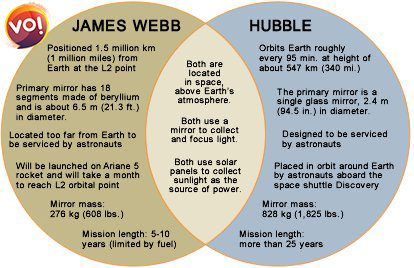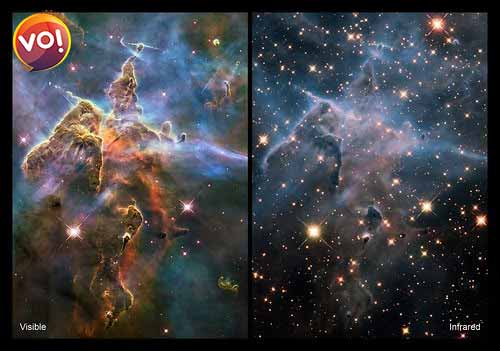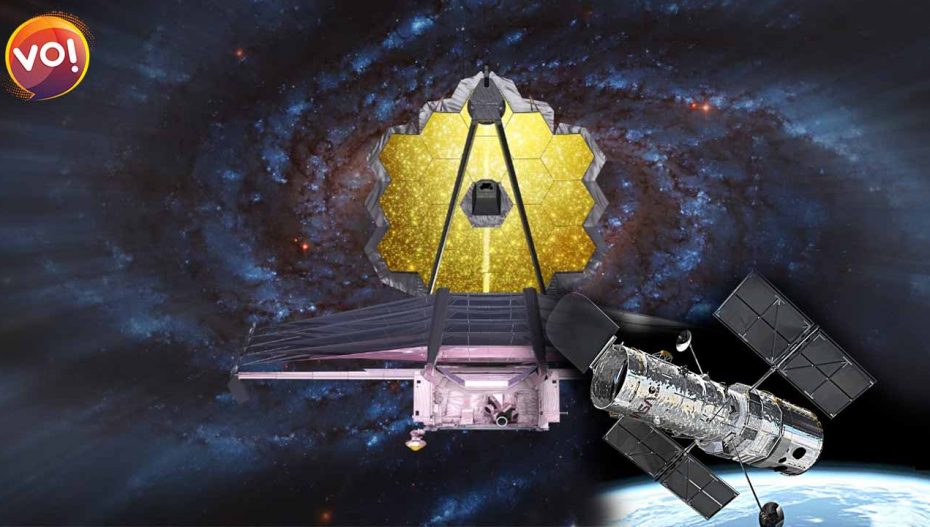Pic: James Webb (behind) and the Hubble (bottom right)
To begin with: Ever wondered how we get weather updates or use GPS tracking? How traffic on highways is reflected on your smartphone? Very simply put, satellites are put into sky to snap, record and relay the information to Earth. The images and info they document on their scanner is transmitted to monitoring centres on Earth.
Who puts satellites into space? The might of science does! And since the US and Russia are known to be forerunners where space and Astrophysics are concerned, it is the NASA, headquartered in the US which is Earth’s laboratory to understand the happenings in space.

Then what is the International Space Station? The ISS is a space station (crew lives there!!) in low Earth orbit. It is a multinational collaborative project involving five participating space agencies: NASA (United States), Roscosmos (Russia), JAXA (Japan), ESA (Europe), and CSA (Canada). The station serves as a space environment research laboratory in which scientific research is conducted in astrobiology, astronomy, meteorology, physics, and other fields. The ISS is suited for testing spacecraft systems and equipment required for possible future long-duration missions to the Moon and Mars. It circles the Earth in roughly 93 minutes, completing 15.5 orbits per day.
What is the difference between ISS and telescopes? One big difference is the altitude in which they operate. ISS “lives’” in low orbit Earth while the telescopes are further above. ISS is used as a platform to repair the telescopes and other satellites orbiting the Earth. For instance, ever since its launch in 1990, the Hubble Telescope has been repaired and upgraded five times. Space mission are sent to the ISS and from there, the telescope and other satellites are accessed. The ISS is like a base in space. Telescopes are like giant mirrors set in further away space to reflect comets, stars and space activity, birth of new galaxies and asteroids.

Okay, so what is the James Webb Space Telescope? Yes, now to come to the point, James Webb is the most advanced telescope ever built. JWST cost at least $11.23 billion, including design, construction, and five years of operations (does not include extended mission funding) or international contributions
A little backgrounder: JSWT was put into space in December 2021. The current hype is about the first set of images into “deeper space” that will be sent back to Earth after nearly six months in space. Remember, with so many thousands of light years away, it took time to send back the clicks and hence the hype.
NASA’s James Webb Space Telescope, a partnership with ESA (European Space Agency) and the Canadian Space Agency (CSA), will release its first full-color images and spectroscopic data on July 12. As the largest and most complex observatory ever launched into space, Webb has been going through a six-month period of preparation before it can begin science work, calibrating its instruments to its space environment and aligning its mirrors. This careful process, not to mention years of new technology development and mission planning, has built up to the first images and data: a demonstration of Webb at its full power, ready to begin its science mission and unfold the infrared universe.
JSWT replaced the Hubble: JSWT was put to help the ageing Hubble. Launched in 1990, Hubble has been observing the universe for over 31 years. It has taken over 1.5 million observations of the universe, and over 18,000 scientific papers have been published with its data. It has contributed to some of the most significant discoveries of our cosmos, including the accelerating expansion of the universe, the evolution of galaxies over time, and the first atmospheric studies of planets beyond our solar system. Hubble retires sometimes in the 2030s. Due to a force called atmospheric drag, which affects the orbits of satellites like Hubble in low-Earth orbit, Hubble’s altitude is slowly decreasing.

Differences between the Hubble and JSWT: Webb has a much bigger mirror than Hubble. This larger light collecting area means that Webb can peer farther back into time than Hubble is capable of doing. Above all, JSWT has the ability to, and is designed to primarily detect infrared light, leading to unique and stunning images. Hubble, on the other hand, can observe light at optical and ultraviolet wavelengths. While the Webb telescope is about a million miles away, the Hubble is roughly 340 miles. Therefore, Webb can look deeper into space. And further into light years away.
Also Read: Scientists Begin Countdown To July 12 Date With Webb Images












